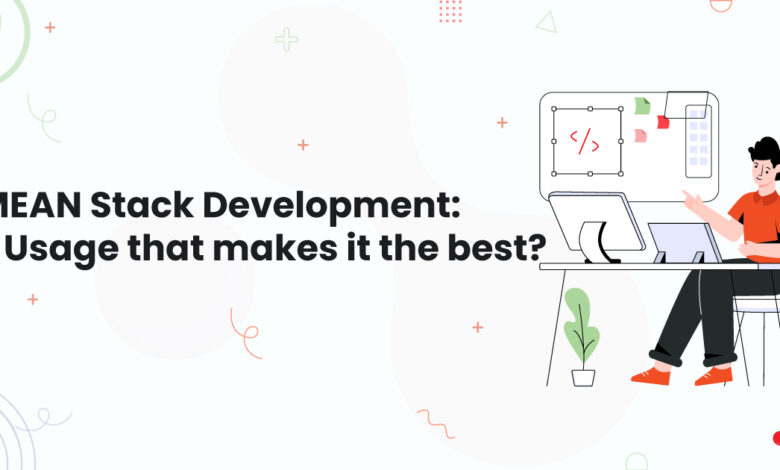MEAN Stack Development: 7 Usage that makes it the best?

Introduction
Full stack development offers major advancements for enterprises or corporations that view cost savings as a means of leveraging new use cases for company development. Why? Full stack development facilitates frontend and backend development simultaneously, hence optimizing resources. MEAN Stack development supports the ideal technological stack for developing web and mobile apps, aligning with a complete stack development strategy
You will learn why you should consider MEAN Stack for any upcoming software development or application projects, whether small or enterprise-scale.
Let us first understand what MEAN Stack Development is.
What is MEAN Stack Development?
MEAN Stack got its name by combining the initials of four important technologies: Node.js, Express.js, AngularJS, and MongoDB.
MEAN is a framework for cloud-based apps that is fully supported by JavaScript.
- NoSQL document database MongoDB
- Express.js is a Node.js web application framework.
- AngularJS is a framework for frontend JavaScript.
- The JavaScript-based web server, Node.js
Angular.JS is replaced by React.js in MERN and AngularJS is replaced with MEVN Vue.js in MEAN, among other changes. MEAN Stack, on the other hand, consistently seems to be the best frontend framework when it comes to top JavaScript application frameworks.
Further, let us understand what are the use cases in MEAN Stack Development
7 Exciting Use Cases of MEAN Stack Development
- Single Page Applications (SPAs): Perfect for creating dynamic, responsive websites that load all content through a single web page dynamically.
- Real-Time Applications: Ideal for applications requiring instant data updates, like live chat apps and collaborative platforms.
- Enterprise Web Applications: Suitable for large-scale business applications due to its scalability and robust backend capabilities.
- E-commerce Sites: Supports complex features required for online stores, such as product management, shopping carts, and user accounts.
- Content Management Systems (CMS): Can be used to develop customizable, scalable content management systems with user-friendly admin panels.
- Social Media Platforms: Effective for creating social networks with features like user interactions, real-time updates, and multimedia content management.
- Cloud-Native Applications: Great for building applications that fully leverage cloud computing capabilities, including scalability and distributed processing.
Now, let us understand how efficient is MEAN Stack Development?
How efficient is MEAN Stack Development?
The three-tier software development approach is part of an effective architecture that is supported by the MEAN stack. Three “tiers” or “layers” make up the architecture, which is designed to make client-server system development simple. This design categorizes three essential components of a client-server system, which offers distinct advantages for both production and development. These components include,
- The display tier and user interface (Angular.js)
- Application/business logic layer (Node.js & Express.js)
- Database tiers and data storage levels (MongoDB)
Now, moving further let us understand how MEAN Stack Development actually functions?
How does MEAN Stack Development actually function?
When you hire MEAN stack developers ensure they are capable of dealing with JavaScript and JavaScript Object Notation or JSON in order to construct online applications or websites. This allows structured data to be represented using a common text-based format.
In web application development, developers utilize JSON to show the program on a web page, transferring data from the server to the client. Therefore, MEAN Stack development makes all of these tasks simple.
MongoDB for data storage
Having a data repository for various documents, including content, user profiles, uploads, comments, and many more for storage, is essential while designing an application. It is simpler to work with technologies like Angular, Express.js, and Node.js when a database is in place.
In this case, MongoDB proves to be an excellent database for storing JSON documents that are obtained from Express.js and Angular.js. On the other hand, MongoDB offers a productive way to store your data if you are developing your application in the cloud.
Angular.js – User Interface/Front End Tier
Modular View Whatever, or Angular.js, is an advanced JavaScript-powered MVW infrastructure that is the highest technological stack in MEAN Stack development.
Angular.js makes it simple and quick to create interactive online apps or user interfaces because it lets you explore HTML tags with metadata, unlike static HTML, JavaScript, or jQuery.
Angular is the most effective and fast front-end framework for back-end interaction.As a result, this framework allows for speedier form validation, such as built-in form validation or JavaScript validation for localization, customization, and communication.
Express.js and Node.js Application Tier
As we’ve seen, Express.js and Node.js are essential to each other in MEAN stack development. Express.js is a basic web framework that builds apps using Node.js.
Some of Express.js’s most well-known features include
HTTP requests and answers for URL routing
With the aid of Express.js, you may improve the performance of your application while interacting with XML HTTP Requests, POSTs, or GETs from Angular.js.
It is based on the V8 runtime environment engine of Chrome and uses Express.js to make all of these tasks possible. Data is accessed by Express.js from Node.js drivers for MongoDB.
Now, let us quickly understand the Key Features of MEAN Stack Development
What are the Key Features of MEAN Stack Development?
- Single Language Stack: Using JavaScript at every stage of the application is one of the main benefits of the MEAN stack. Because everything is written in the same language—from the client to the server to the database—it is simpler to maintain clean, consistent code.
- Support for Model-View-Controller (MVC) design: MEAN facilitates the MVC design pattern, which helps to maintain the organization and readability of application code.
- High Performance: MEAN stack apps are quick and extremely scalable because to Node.js’s non-blocking architecture and Angular.js’s effective front-end processing.
- Open Source and Community Driven: The MEAN stack’s technologies are all free and open-source, which lowers the cost of development. Every component of the stack also features a robust ecosystem of libraries and developer-supporting tools, as well as a vibrant community.
- Reusable and Maintainable Code: The maintainable structure offered by Angular.js facilitates code reuse, hence lowering development effort and redundancy.
- Extensible and Flexible: MongoDB has an extensible document model that works well for managing a wide range of data kinds and quantities. Maintaining clean, consistent code is simpler because the same language is used throughout the client, server, and database
Now, let us understand some useful statistics and Key aspects of MEAN Stack Development
Statistics and Key Aspects of MEAN Stack Development
| Nature | Description | Unique Benefits | Statistics |
|---|---|---|---|
| Single Language Stack | Utilizes JavaScript across all layers of the stack, simplifying development and maintenance. | Facilitates easier debugging and streamlined updates across the stack. | JavaScript is used by 69.7% of developers globally. |
| MVC Support | MEAN stack supports the Model-View-Controller architecture, enhancing code organization and scalability. | Simplifies collaboration among developers working on large-scale projects due to organized code structure. | Enhances code maintainability noted in 80% of MVC-using projects |
| Open Source Community | All technologies within MEAN are open-source, backed by strong community support. | Reduces development costs and accelerates innovation through community-driven improvements and plugins. | 95% of enterprises report using open-source software |
| JSON Everywhere | MEAN uses JSON for data transmission, allowing seamless handling and storage of data in MongoDB. | Streamlines data interchange between client and server, and integration with other systems and APIs. | JSON increases data interchange efficiency by up to 60% in web applications |
| Cloud Compatibility | MEAN is designed with cloud functionalities in mind, with MongoDB providing robust support for cloud services. | Lowers the operational costs and enhances the scalability of applications with cloud-based deployments. | 73% of organizations using cloud-native technologies prefer MongoDB for flexibility |
Now, lastly let us understand how Acquaint Softtech can help with MEAN Stack Development
How Acquaint Softtech can help with MEAN Stack Development?
Software development outsourcing and IT staff augmentation are services offered by Acquaint Softtech, an IT outsourcing provider. As an official Laravel partner, we take great pride in using the Laravel framework to create innovative projects.
Acquaint Softtech is the best choice if your business needs to hire remote developers. Thanks to our accelerated onboarding process, developers can join your current team in 48 hours.
Because of low $15 hourly prices, we are also the best choice for any software development job that is outsourced. We can help you to hire MEAN stack developers and hire MERN stack developers, hire remote developers, and outsourced services to meet your demands for custom development.
Wrapping Up!
The MEAN stack, embodying the synergy of MongoDB, Express.js, AngularJS, and Node.js, offers a seamless and powerful framework for developing versatile web applications. It simplifies processes across the board—from development to deployment—ensuring that enterprises can launch robust, scalable, and efficient applications.
At Acquaint Softtech, we leverage this dynamic stack to bring your innovative projects to life, consistently and cost-effectively. With our expertise and rapid onboarding, we’re not just participating in the industry—we’re helping to shape its future, making advanced technology accessible and manageable for businesses looking to thrive in the digital age.



